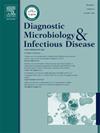The role of Copeptin in viral lower respiratory tract infections in child: A prospective case-control study
IF 2.1
4区 医学
Q3 INFECTIOUS DISEASES
Diagnostic microbiology and infectious disease
Pub Date : 2024-12-01
DOI:10.1016/j.diagmicrobio.2024.116641
引用次数: 0
Abstract
Background
Lower respiratory tract infection (LRTI) is a leading cause of morbidity and mortality among children globally. Copeptin, released by the pituitary gland, serves as a biomarker for various conditions and, as a neuroendocrine stress hormone, is useful in acute conditions. This study aimed to determine the role of copeptin levels in LRTI in children and whether it can reliably predict pneumonia severity.
Materials and Methods
This prospective case-control study was performed between April and October 2023. The study included four groups: (i) patients diagnosed with bronchiolitis (Group 1, n=25), (ii) patients diagnosed with mild to moderate pneumonia (Group 2, n=25), (iii) patients diagnosed with severe pneumonia (Group 3, n=25), and (iv) a control group (Group 4, n=26).
Results
Copeptin values differed significantly between the groups (p<0.001 for all comparisons). Copeptin demonstrated a sensitivity of 87.4 % and specificity of 82.2 % for distinguishing between patients with bronchiolitis and pneumonia, using a cut-off value of >0.586 ng/ml. For the identification of patients with severe pneumonia versus those with mild to moderate pneumonia, copeptin exhibited a sensitivity of 97.9 % and specificity of 94.7 % with a cut-off value of >1.215 ng/ml. The copeptin level exhibited a positive correlation with fibrinogen and FAR levels while demonstrating a negative correlation with albumin levels (r=0.354, ⁎⁎P=0.002; r=0.408, ⁎⁎⁎P<0.001; and r=−0.334, ⁎⁎P=0.003, respectively).
Conclusions
Copeptin demonstrates potential as a predictor of disease severity in children with pneumonia. It can also serve as a valuable tool to guide physicians in differentiating between bronchiolitis and pneumonia, as well as in diagnosing severe pneumonia.
Copeptin在儿童病毒性下呼吸道感染中的作用:一项前瞻性病例对照研究。
背景:下呼吸道感染(LRTI)是全球儿童发病和死亡的主要原因。Copeptin由脑垂体释放,作为各种疾病的生物标志物,作为神经内分泌应激激素,在急性疾病中很有用。本研究旨在确定copeptin水平在儿童下呼吸道感染中的作用,以及它是否能可靠地预测肺炎的严重程度。材料和方法:本前瞻性病例对照研究于2023年4月至10月进行。研究包括四组:(i)诊断为毛细支气管炎的患者(1组,n=25), (ii)诊断为轻中度肺炎的患者(2组,n=25), (iii)诊断为重度肺炎的患者(3组,n=25),以及(iv)对照组(4组,n=26)。结果:Copeptin值组间差异有统计学意义(p0.586 ng/ml)。对于重症肺炎患者与轻中度肺炎患者的鉴别,copeptin的敏感性为97.9%,特异性为94.7%,临界值为1.215 ng/ml。copeptin水平与纤维蛋白原、FAR水平呈正相关,与白蛋白水平呈负相关(r=0.354, P=0.002;r=0.408, P P=0.003)。结论:Copeptin可作为肺炎患儿疾病严重程度的预测因子。它也可以作为一个有价值的工具,指导医生鉴别细支气管炎和肺炎,以及诊断重症肺炎。
本文章由计算机程序翻译,如有差异,请以英文原文为准。
求助全文
约1分钟内获得全文
求助全文
来源期刊
CiteScore
5.30
自引率
3.40%
发文量
149
审稿时长
56 days
期刊介绍:
Diagnostic Microbiology and Infectious Disease keeps you informed of the latest developments in clinical microbiology and the diagnosis and treatment of infectious diseases. Packed with rigorously peer-reviewed articles and studies in bacteriology, immunology, immunoserology, infectious diseases, mycology, parasitology, and virology, the journal examines new procedures, unusual cases, controversial issues, and important new literature. Diagnostic Microbiology and Infectious Disease distinguished independent editorial board, consisting of experts from many medical specialties, ensures you extensive and authoritative coverage.

 求助内容:
求助内容: 应助结果提醒方式:
应助结果提醒方式:


